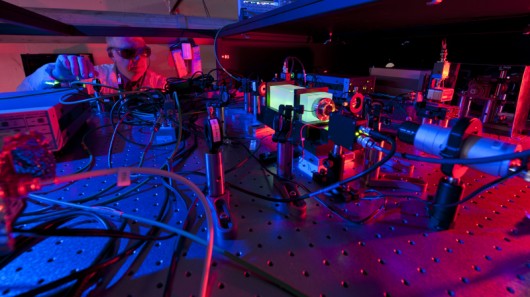
In what may be one of the most mind-bogglingly surreal experiments ever floated, scientists at the US Department of Energy's Fermi National Accelerator Laboratory (Fermilab) will attempt to discover if the universe is "real" or merely a holographic 3-D illusion that we just think is real. Using high-powered lasers, the scientists intend to determine if space-time is a quantum system made up of countless tiny bits of information.
In explaining their theory, the scientists involved make much of the analogy that, if you stand near enough to a TV screen, you will be able to see the individual pixels that, as you move away, image resolves into a whole image with the individual pixels no longer distinguishable as separate points of light.
So, the scientists propose that if the characters displayed on a TV screen don't know that their apparent 3-D world exists only on a 2-D screen, we too could also be ignorant to the possibility that our 3-D space is also just an illusion. As such, the Fermilab scientists believe that the information about everything contained in our universe may somehow be embedded in tiny packets of information in two dimensions.
The scientists further premise that this information is contained in a "pixel size" container approximately 10 trillion, trillion times smaller than an atom, (a dimension of size that physicists call the Planck scale). At this sub-atomic scale, standard physics no longer holds much sway and quantum theory dictates the rules. As such, it is not possible – in accordance with Heisenberg’s uncertainty principle – to know both the precise location and the exact speed of subatomic particles at the same time.
As a result, his phenomenon ensures that matter continues to jitter as quantum waves even when cooled to absolute zero. If the digitized space proposed by the researchers continues to vibrate even in its lowest energy state, they believe that their theory may be proved correct.
To attempt to test this premise, the Fermilab researchers have designed and built what they call a "Holometer" – or holographic interferometer – to see if the characteristic quantum jitter that exists in matter is also found in empty space.
"We want to find out whether space-time is a quantum system just like matter is," says Craig Hogan, developer of the holographic noise theory and a director at Fermilab. "If we see something, it will completely change ideas about space we’ve used for thousands of years."
Recently commissioned and now operating at full power, the Holometer uses a pair of interferometers (devices that superimpose one laser beam over another to look for anomalies in intensity or phase to test an external influence) located next to each other. Each interferometer directs a one-kilowatt laser beam at a beam splitter and then down two 40-m (130-ft) arms located at right-angles to one another.
The laser beams are then reflected and returned to the beam splitter and the two beams are recombined; if there is any motion detected, fluctuations in the brightness of the combined beam will result. Researchers will then analyze these fluctuations to see if the beam is being influenced by the jitter of space itself.
One major difficulty in such a test will be noise – "Holographic noise", the researchers call it – which they expect to be present at all frequencies. To mitigate this, the Holometer is testing at frequencies of many megahertz so that motions contained in normal matter are claimed not to be a problem. The dominant background noise of radio wave interference will be the most difficult to filter out, according to the team.
"If we find a noise we can’t get rid of, we might be detecting something fundamental about nature – a noise that is intrinsic to space-time," said Fermilab physicist Aaron Chou. "It’s an exciting moment for physics. A positive result will open a whole new avenue of questioning about how space works."
The Holometer team is made up of 21 scientists and students from Fermilab, MIT, the University of Chicago and the University of Michigan, with the experiment set to gather data over the coming year.

 Previous page
Previous page Back to top
Back to top







